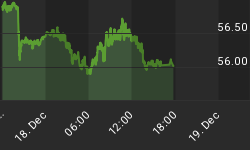We don't think the Fed is afraid of deflation. This is because deflation is something the Fed will always be able to prevent as long as the current monetary system remains in place.
Some of the 'unconventional' tools that would be at the Fed's disposal should deflation ever become a serious threat were described by Ben Bernanke -- the man who will take over the chairmanship of the Fed next month -- in a speech delivered in November of 2002. Also, by engineering a $180B increase in the money supply within the space of only a few days during September of 2001 the Fed demonstrated just how effective its direct money-creation powers can be when 'push comes to shove'. The devastation wrought by terrorists that prompted this sudden injection of money came without warning, so just imagine what the Fed could do given a few months to plan.
But despite a) the incoming Fed chairman having clearly explained why the central bank will never be at a loss when it comes to reducing the purchasing power of the currency and b) the fact that there is solid empirical evidence of the Fed's power to inflate under adverse circumstances, many analysts continue to argue that the Fed will be powerless to inflate if the US consumer ever begins to cut back on his/her borrowing.
The point we think the deflationists are missing is that the consumer has never been, nor ever will be, the engine of inflation. During the 100-year period prior to the Fed's birth the dollar's purchasing power was roughly unchanged, but if you take a 1913 dollar (the Fed was created in 1913) and cut its purchasing power in half...then cut it in half again...and then cut it in half again...and then cut it in half yet again...you end up with the purchasing power equivalent of a 2005 dollar. Not surprisingly, almost all of this decline in purchasing power occurred after the 1933 removal of US citizens' ability to exchange dollars for gold at a fixed rate. In effect, what has transpired since the Fed's creation could reasonably be described as a slow-motion collapse of the dollar.
What we think the Fed fears more than anything else -- certainly a lot more than it fears deflation -- is an uncontrolled surge in inflation expectations. The dollar's slow-motion collapse can continue almost indefinitely, with the Fed injecting money in response to the occasional deflation scare and pushing short-term interest rates up when inflationary pressures begin to show through, as long as the public doesn't come to believe that the dollar will lose its purchasing power at an ever-increasing pace. However, if the public began to anticipate acceleration in the rate at which the dollar loses its purchasing power then prices would begin to rise much faster than would be justified by increases in the money supply alone, and bond yields would rocket upward. This is why the Fed must keep hiking short-term interest rates until inflation expectations are most definitely under control, regardless of how much damage the rate hikes are perceived to be causing to the economy. If they overdo the rate hikes they can always inject enough new money later to re-energise the inflation trend, but sharply rising inflation expectations would be a life-threatening problem for the current monetary system. The bottom line is, soaring long-term interest rates -- a guaranteed effect of letting inflation expectations get out of hand -- would be far more damaging than any problem caused by overly tight monetary policy.
Yes, we know this is exactly the opposite of conventional wisdom. Almost everyone thinks that the Fed will do anything -- including tolerating a much more rapid decline in the purchasing power of the dollar -- to mitigate the risk of a deflationary outcome. And Fed representatives never miss a chance to bolster this line of thinking because such thinking is necessary in order to keep the game going. After all, who would invest in 30-year US Treasury debt yielding 5% if it were known that there was no chance of deflation and that an additional large decline in the purchasing power of the dollar was all but guaranteed? The Bank of Japan might, but no private investor in his/her right mind would.
The truth of the matter, as we see it, is that the Fed has the tools to keep the inflation going and it KNOWS it has the tools to keep the inflation going. The Fed's biggest fear is that everyone else figures this out.
















